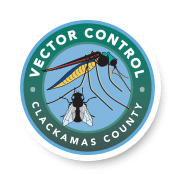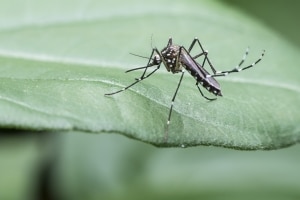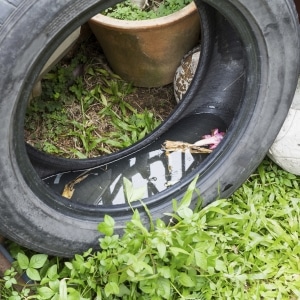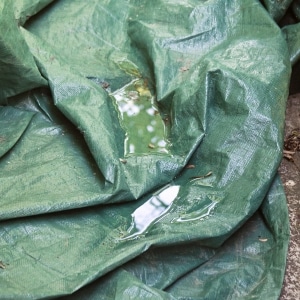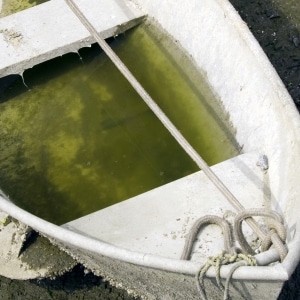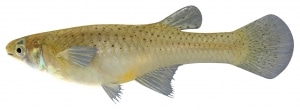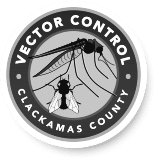Mosquito control is the process of actively reducing the number of mosquitoes. Comprehensive mosquito control can use one or more approaches that target different environments and life stages of the mosquito.
There are four basic approaches to controlling mosquitoes: prevention, source reduction, larviciding and adulticiding. Preventing mosquitoes from breeding is the most desirable solution. Unfortunately, many human modifications of the environment such as ditches, retention ponds, and water management structures create mosquito breeding sites. Prevention requires working with planners to plan, construct, and maintain infrastructure without producing mosquito breeding habitats.
Source reduction is the elimination of water in which mosquitoes lay their eggs and in which the larvae develop or by containing water to eliminate areas for mosquitoes to lay their eggs. Source reduction is the second most effective method for controlling mosquitoes. Methods of source reduction involve eliminating containers that hold water and filling wet areas with soil.
When source reduction fails or is not possible after public outreach and education then the next course of action is larviciding. Larviciding is the use of pesticides to control immature stages of mosquitoes or prevent development of larvae from becoming adult mosquitoes. When applied to waters containing larvae and or pupae, larvicides offer protection against the emergence of adult mosquitoes. Applying larvicides according to the pesticide label minimizes negative impacts to other organisms in the water and habitat. We do our best to not cause undue harm to non-target species.
In addition to efforts to control larval concentrations and environments, there are still scenarios that need increased effort and adult mosquito control. This is where we rely on population dynamics and distributions that we compile based on our trapping program with thresholds set by our team. Following the label as directed, adulticides can be effective for adult control. We use barrier sprays to apply an irritant pesticide to foliage around residents’ properties to protect them from adult mosquitoes harboring around the perimeter of their property. Applying barrier sprays to non-flowering plants early in the morning before bees are out is one of the ways we mitigate impacts on non-target species. Once the sprays are dry, there is also less of an impact on non-target species. We do not regularly spray public areas throughout the county. We do have a ULV fogger on a truck that is calibrated every season as a contingency plan if we did have an unsafe number of vector-competent species with a threat to public health or an active outbreak. Running the fogging truck through neighborhoods is not something that we do in our regular day-to-day operations at the District as it would have the most negative impact on non-target species upon application.
On-site assessment, monitoring and remediation: District staff maintains a survey of mosquito breeding sites in Clackamas County. This survey is updated regularly and each location is mapped and recorded. Each location is checked regularly and treated as necessary during the breeding season. However, a significant portion of the County mosquito problems originate from backyard pools, which are not surveyed but can be checked if requested by the owner.
Vector Control will be increasing surveillance of adult mosquito populations dynamics and distribution throughout the county with a new trapping program. This will give us the data needed to make informed decisions about when and where pesticide should be used in an environmentally responsible way. We are also starting resistance testing through larval and adult bioassays to make sure pesticides are not overused or misused in the county.
Biological control: Alternative to pesticide, biological control is an important part of our mosquito control program. Staff grows and distributes Gambusia affinis, a fish that feeds on mosquito larvae, to any citizen of the county. Use of such fish reduces the amount of pesticide required to control mosquitoes.
FISH HELP PREVENT MOSQUITOES
“Mosquito fish” (Gambusia affinis), are important to our mosquito control program. They eat mosquito larvae as fast as they hatch from the eggs. Mosquito fish are furnished without charge for stocking ornamental ponds, unused or “out-of-order” swimming pools, and animal water troughs. They require no feeding and care is limited to protecting them from garden sprays and from chlorine or other chemicals used to clean the pond. Gambusia affinis help to eliminate the need for frequent spraying with mosquito products.
These fish are invasive in natural habitats and are provided only when they will be contained to man-made bodies of water and there is no risk of them escaping to natural water bodies.
Facts About Mosquito Fish
Mosquito fish do not lay eggs, but rather give birth to well developed and very active young. These fish therefore require no special environment for depositing and hatching eggs. The earliest broods of the season are born in April and May, however, they breed throughout the summer with 50 to 100 young in a single brood. The young are approximately 1/4 inch in length when born and are ready to begin destroying mosquito larvae at once. Gambusia grow rapidly, reaching a maximum size of about three inches.
HIT MOSQUITOES WHERE THEY LIVE!
Beware of Dead Water in:
- Bird Baths, Buckets & Barrels
- Boats, Bilges & Covers
- Ponds & Water Features
- Concrete & Plastic Pools
- Gutters & Downspouts
- Neglected Hot Tubs & Pools
- Tires, Cans & Wheel Barrows
- Plant Pots & Saucers
- Leaking Hoses & Sprinklers
- Puddles, Troughs & Ditches
FIGHT THE BITES!
How to best avoid getting bitten by mosquitoes this spring, summer and fall? Stay inside or in screened-in areas during sunrise, sunset, and early evening. Cover up with long sleeves, long pants, socks, and closed shoes. Plug in a fan to keep you cool, mosquitoes don’t like moving air. Light citronella candles, tiki torches or even a fire pit where safe. Keep mosquitoes from breeding in your yard by dumping any stagnate water.
